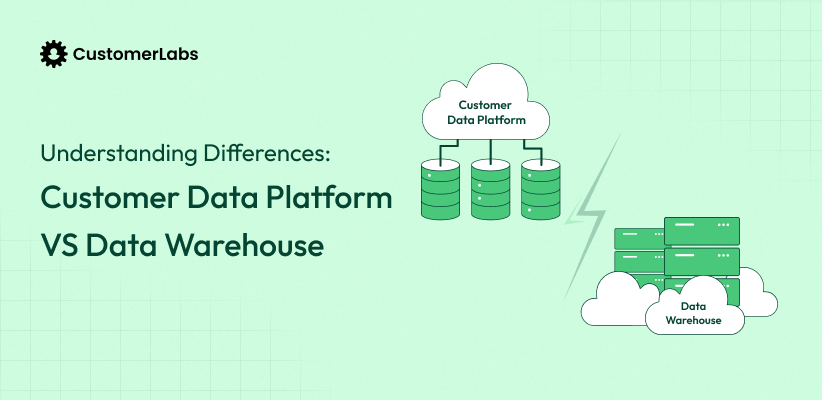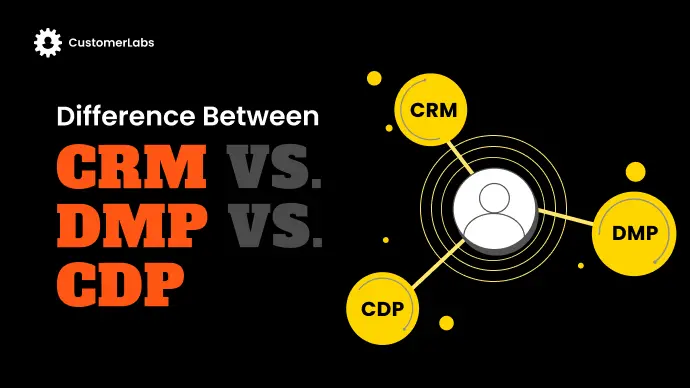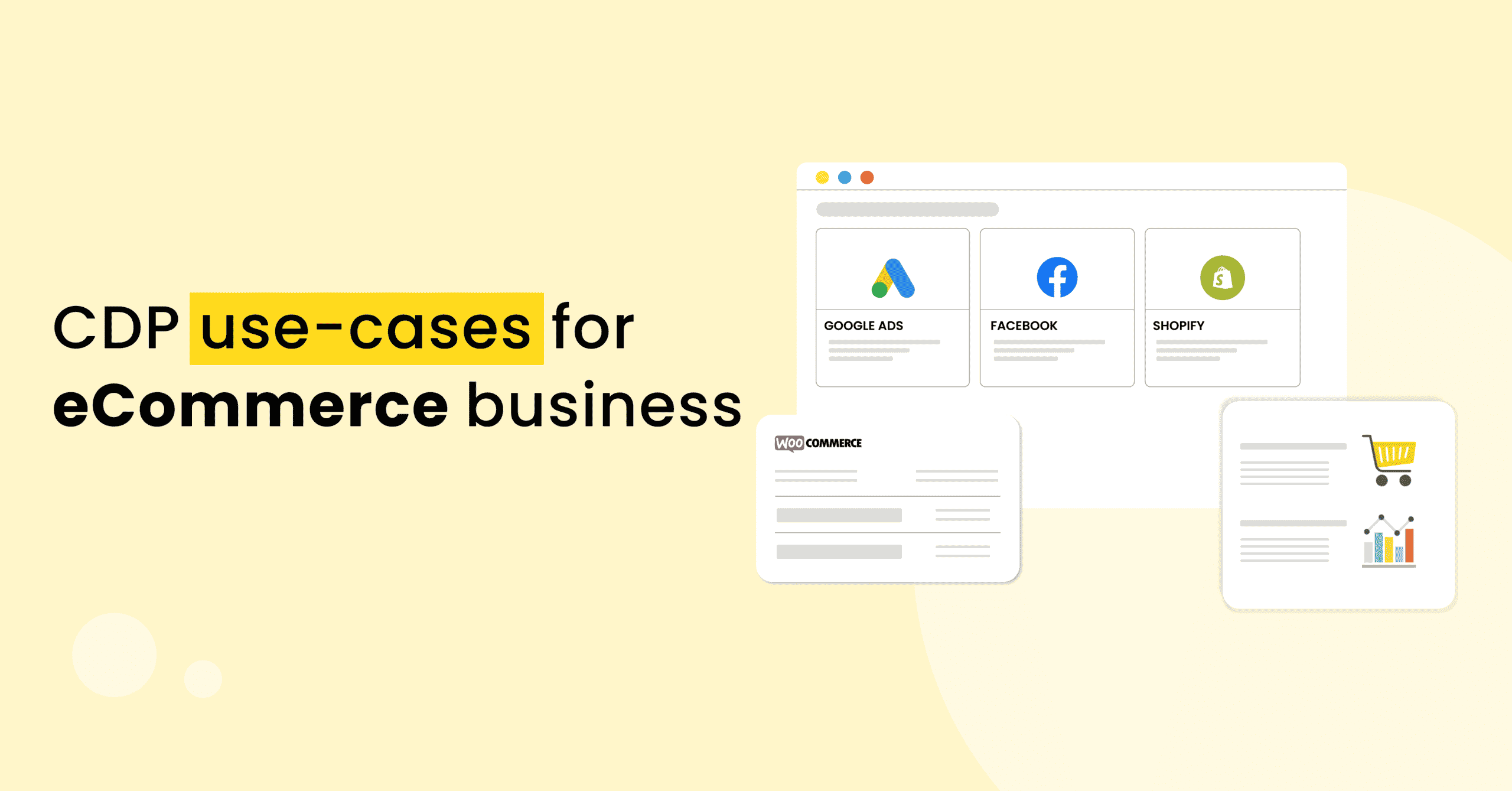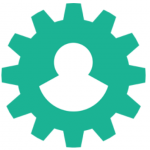Diving in a fragmented MarTech stack may not provide a seamless customer experience. Hence, without a central source of truth for your data, you’ll be left juggling isolated insights from CRM systems, DMPs, and data lakes—all of which limit your ability to build a consistent, cohesive view of your customers.
To deliver relevant, personalized campaigns that boost ROI, you need a solution that unifies data from every touchpoint, enabling you to craft well-informed, cross-channel marketing strategies.
A Customer Data Platform (CDP) steps in as that crucial link, offering not only centralized data management but also the ability to activate customer insights in real time. As you consider the role a CDP could play in your MarTech stack, this guide will show how it fits alongside other tools, maximizing your reach while simplifying workflows and enhancing data-driven precision.
How to Integrate a CDP Into Your MarTech Stack
Integrating a CDP into your existing Marketing Technology (MarTech) stack is a crucial move for businesses aiming to deliver personalized, data-driven marketing strategies. However, for the integration to be effective, it’s important to understand not just the technical aspects, but also how the CDP fits into the broader ecosystem of tools and platforms that make up your MarTech stack.
Here’s a step-by-step breakdown of how to successfully integrate a CDP into your MarTech stack, and why it’s essential to ensure the CDP works seamlessly with other tools.
1. Understand How the CDP Collaborates with Existing MarTech Components
Before diving into the technical integration, you must first understand how the CDP interacts with other components in your stack. A well-integrated CDP doesn’t work in isolation; it should communicate effectively with other systems such as:
- CRM (Customer Relationship Management): A CDP complements your CRM by enhancing customer data, providing a unified view of customer interactions, and enriching CRM data with more granular insights.
- Marketing Automation Tools: The CDP collects and centralizes customer data, which can then be leveraged by marketing automation platforms to create personalized email campaigns, trigger workflows, and more. The real-time data from the CDP helps these tools send relevant messages at the right time.
- Analytics & Reporting Tools: Integrating a CDP with analytics platforms allows marketers to leverage rich, unified customer data for in-depth analysis and reporting. This ensures that your insights are based on a comprehensive view of your customers’ behavior.
- Data Management Platforms (DMPs): While both CDPs and DMPs handle customer data, a CDP provides a more persistent and unified view of the customer across all touchpoints, unlike DMPs that focus more on anonymous data (such as cookies). A well-integrated CDP complements and enhances the functionality of a DMP.
In essence, the CDP serves as the central hub of your MarTech stack, bringing together data from multiple sources and making it actionable for other tools.
2. Prioritize Data Quality and Consistency
To fully leverage a CDP within your MarTech stack, it’s essential to focus on data quality. The CDP functions best when the data it centralizes is consistent, accurate, and up-to-date. This often involves cleaning and normalizing data from disparate systems (e.g., CRM, website interactions, social media, etc.) to ensure it’s unified and usable.
In many MarTech stacks, companies work with multiple data sources that may have inconsistent formats, structures, or incomplete datasets. A good CDP integration process includes setting up data validation rules, deduplication processes, and ensuring that data from different sources is harmonized before it enters the platform.
By prioritizing clean, structured data, you ensure that all downstream systems—whether it’s a CRM, email automation tool, or analytics platform—are receiving high-quality, accurate information, which enhances their effectiveness.
3. Leverage Real-Time Data for Dynamic Marketing Campaigns
One of the primary advantages of integrating a CDP into your MarTech stack is the ability to leverage real-time customer data for personalized and timely marketing campaigns. By continuously collecting data from various touchpoints (e.g., website visits, social media interactions, email responses), a CDP allows you to segment your audience dynamically based on their behaviors, preferences, and lifecycle stage.
For example, if a customer browses products on your website but doesn’t complete a purchase, the real-time data captured by the CDP can trigger a personalized email or retargeting ad to remind them about the product or offer a discount. This level of personalized marketing is only possible when your CDP is properly integrated with other platforms in your MarTech stack, such as email marketing tools or ad networks.
Moreover, by integrating the CDP with analytics tools, you can gain deeper insights into campaign performance and adjust your marketing strategies in real time based on customer behavior. This creates a feedback loop where data is constantly flowing between your tools and being used to refine your campaigns.
4. Align with Your Business Goals and Marketing Objectives
Integrating a CDP into your MarTech stack isn’t just about the technology—it’s about ensuring that the data you’re collecting aligns with your overall business objectives. A CDP should support your goals, whether that’s improving customer retention, driving conversions, or enhancing the customer experience.
It’s important to define clear business goals that will drive how the CDP is used. For example:
- Customer Retention: Use the CDP to identify at-risk customers and tailor retention strategies through personalized offers or communication.
- Customer Acquisition: Leverage the CDP to create detailed customer segments and target new prospects with highly relevant ads or campaigns.
- Enhanced Personalization: Ensure the CDP enables you to serve tailored content, product recommendations, and offers based on detailed customer profiles.
By aligning the CDP’s capabilities with your strategic marketing goals, you can create more targeted and effective campaigns that drive measurable results.
5. Ensure Cross-Functional Collaboration
Finally, integrating a CDP into your MarTech stack requires collaboration across different teams in your organization. The integration of a CDP typically involves not only the marketing team but also IT, data scientists, and customer service teams. It’s crucial to have cross-functional alignment so that the platform is set up to meet the needs of various stakeholders, and the data is used efficiently across the company.
IT teams should be involved in setting up the necessary technical infrastructure to support the CDP, while marketing teams will be responsible for leveraging customer data to personalize campaigns. Regular communication between departments will ensure the CDP continues to evolve and deliver value to the business.
The Need for a CDP in Your MarTech Stack
In today’s digital space, having a MarTech CDP in your stack is crucial for creating a consistent customer experience. With a CDP, you can consolidate fragmented customer data from various channels and sources, breaking down silos that can hinder personalized marketing.
1. Centralizing Customer Data
A CDP aggregates and unifies customer data from disparate sources into a single, accessible profile. With a CDP integrated into your MarTech stack, you can break down data silos, offering a 360-degree view of your customers. This centralized repository becomes the backbone of your marketing efforts, empowering personalized campaigns, improved targeting, and better customer experiences.
2. Enabling Real-Time Decision Making
One of the most significant advantages of a CDP is its ability to provide real-time data updates. Unlike traditional systems that may rely on batch processing or outdated data, a CDP continuously refreshes customer profiles, allowing your marketing team to make informed, timely decisions. This real-time capability ensures that you’re always working with the most current data, improving agility in campaign execution and customer engagement.
3. Seamless Integration with Existing Tools
A well-integrated CDP can work alongside your other MarTech components (such as CRM, email marketing platforms, analytics tools, etc.). It acts as a bridge between different tools, ensuring they share accurate and consistent customer data. As a result, marketing campaigns are more aligned, customer communications are personalized, and the overall marketing strategy is more effective. This harmony within the stack creates operational efficiency and reduces the risk of errors stemming from data fragmentation.
4. Optimizing Customer Experiences
A unified, single view of the customer allows you to deliver more relevant content and offers. By utilizing the insights generated by your CDP, you can personalize every aspect of the customer journey—whether it’s automated email sequences, dynamic website content, or tailored ads. Personalized experiences lead to increased customer satisfaction, higher conversion rates, and ultimately, better ROI on your marketing efforts.
A CDP helps you centralize and unify customer data, enable real-time decision-making, optimize customer experiences, and align your MarTech tools. In a world where data drives success, a CDP is no longer a “nice-to-have” but a necessity for achieving seamless, personalized marketing and better business outcomes.
Fitting CDP into the MarTech Stack
Integrating a Customer Data Platform (CDP) within your MarTech stack allows you to leverage advanced data capabilities that other systems, like CRMs, DMPs, and data lakes, often lack.
While each of these tools serves specific functions—CRMs for managing customer relationships, DMPs for anonymous data targeting, and data lakes for large-scale data storage—a CDP’s centralized data management capability provides a uniquely unified, actionable customer view.
- Distinct Purpose: A CDP consolidates structured and unstructured data to offer a comprehensive profile, setting it apart from CRMs, DMPs, and data lakes.
- Seamless Data Access: With a CDP, performance marketers gain real-time access to customer data across all channels, making it ideal for personalization and targeted campaigns.
Integrating a CDP like CustomerLabs ensures that you have access to centralized, ready-to-use data that fits seamlessly within the broader MarTech ecosystem, empowering you to reach customers with precision.
Categories of Customer Data Management Systems
To maximize a CDP’s impact, it’s essential to understand its role within the larger data ecosystem, where data moves through distinct systems for efficient processing and utilization.
CDM systems can be divided into several categories, each designed to play a specific role in managing and utilizing customer data. Let’s dive into these categories and see what each one does.
1. Customer Relationship Management (CRM) Systems
- Purpose: CRM systems are built to manage and analyze customer interactions over time, helping businesses track and strengthen their relationships with customers.
- Key Features:
- Contact Management: Organizes and stores customer information, ensuring your team can quickly access relevant details.
- Sales Tracking: Tracks the customer journey, from initial interest to final purchase, so you can optimize your sales process.
- Customer Support & Service: Provides tools to manage customer support tickets, ensuring quick resolution of issues.
- Marketing Automation: Automates tasks like sending promotional emails, reminders, or newsletters based on customer behavior.
2. Master Data Management (MDM) Systems
- Purpose: MDM systems create a single, accurate view of customer data across different systems within an organization. They help ensure that customer information is consistent and up-to-date.
- Key Features:
- Data Integration: Combines data from different sources to create a unified, 360-degree view of each customer.
- Data Quality Control & Governance: Ensures the accuracy and consistency of data by cleaning and standardizing information.
- Centralized Data Repository: Stores all customer data in one place, ensuring consistency across departments.
3. Data Integration Platforms
- Purpose: These systems help integrate and consolidate customer data from multiple sources, such as websites, social media, email platforms, and CRMs. They ensure that all your data can work together smoothly.
- Key Features:
- Data Mapping & Transformation: Converts data into a format that can be used across different systems.
- Real-Time & Batch Data Processing: Handles both real-time data (such as live website interactions) and batch data (collected in chunks, like weekly sales data).
- API-Based Integrations: Enables systems to connect seamlessly, allowing for better data exchange across platforms.
4. Data Warehousing Solutions
- Purpose: Data warehousing solutions store large volumes of data from various sources. They allow businesses to store both structured (like customer names and addresses) and unstructured data (like social media posts) in a central location for analysis.
- Key Features:
- Data Storage: Efficiently stores massive amounts of customer and operational data.
- Data Reporting & Analytics: Provides tools to analyze the data for actionable insights and decision-making.
- Data Consolidation: Brings together data from various sources, making it easier to get a complete picture of customer behavior.
5. Data Analytics Platforms
- Purpose: These systems help businesses analyze customer data to uncover trends, behaviors, and insights that drive better decision-making.
- Key Features:
- Predictive Analytics: Uses historical data to predict future customer behavior or sales trends.
- Segmentation: Divides customers into specific groups based on shared characteristics, allowing for targeted marketing.
- Behavioral Analysis: Tracks and analyzes customer actions, such as website visits or product purchases.
6. Customer Data Platforms (CDPs)
- Purpose: CDPs unify all customer data into a single platform, creating a comprehensive customer profile that can be used for personalized marketing.
- Key Features:
- Real-Time Data Collection: Gathers data from multiple touchpoints, including websites, apps, and CRM systems, in real time.
- Customer Segmentation: Allows marketers to group customers based on behavior, demographics, and purchase history.
- Data Activation: Makes the customer data actionable by pushing it to other systems, such as marketing automation or email platforms.
7. Data Governance Systems
- Purpose: These systems help businesses ensure that customer data is managed in compliance with regulations, such as GDPR, CCPA, or HIPAA.
- Key Features:
- Data Privacy: Ensures customer data is stored and processed securely, and customer consent is obtained where needed.
- Data Security: Implements encryption, access control, and monitoring to protect sensitive information.
- Compliance Management: Tracks and manages data processing activities to ensure adherence to legal and regulatory requirements.
8. Marketing Automation Platforms
- Purpose: These systems help automate and streamline marketing efforts by using customer data to trigger targeted campaigns and personalized content.
- Key Features:
- Email Campaign Automation: Automatically sends personalized emails based on customer behavior or predefined triggers.
- Lead Scoring & Nurturing: Identifies and nurtures high-potential leads, guiding them through the sales funnel.
- Multi-Channel Campaigns: Manages campaigns across multiple channels, such as email, social media, and paid advertising.
Selecting the Right CDP for Your Needs
Finding the right CDP starts with thoroughly understanding your organization’s unique goals and challenges. By focusing on the specific use cases that a CDP will serve, you can pinpoint solutions that align with your requirements and avoid features that may be unnecessary. Here are a few key considerations to guide your selection process:
Questions to Ask Before Choosing a CDP:
- What specific goals do we want to achieve with a CDP?
- What challenges are we currently facing with data unification and activation?
- How well will the CDP integrate with our existing tools?
Answering these questions greatly helps you to choose the right CDP that meets your business needs. With so many options available among CDPs, what makes CustomerLabs stand out is that. Let’s see why CustomerLabs is the right choice.
Why CustomerLabs is the Perfect Fit for Your MarTech Stack
CustomerLabs is designed to simplify marketing operations for small and growing businesses, offering tools that make data management easier rather than more complex. Unlike many customer data platforms (CDPs) that cater to large enterprises with complicated systems, CustomerLabs prioritizes usability and accessibility for teams of all sizes. Its feature-rich platform provides enterprise-grade capabilities at an affordable cost, helping businesses unify data, activate first-party insights, and streamline workflows quickly.
What Makes CustomerLabs Stand Out?
- Effortless Data Unification: Simplifies the collection and activation of first-party data without needing technical expertise.
- Affordable for Growing Businesses: Offers powerful features at a low cost, ideal for startups and small businesses.
- Seamless Integration: Integrates smoothly with your existing marketing tools, analytics, and CRMs, eliminating data silos.
- Privacy-First Approach: Prioritizes consumer data protection, ensuring full compliance with data regulations.
With CustomerLabs, you can personalize campaigns, boost ROI, and scale operations without the complexity often associated with traditional CDPs. Whether you’re looking for actionable insights, advanced segmentation, or a seamless MarTech ecosystem, CustomerLabs helps you grow your business efficiently.
Conclusion
Incorporating a CDP into your MarTech stack is pivotal for any performance marketer aiming to unify customer data and deliver a seamless, personalized experience.
By understanding a CDP’s role, distinguishing it from other data systems, and focusing on essential functionalities and advanced features, you gain the insights needed to make data actionable across your marketing channels.
For those seeking a streamlined approach, CustomerLabs CDP offers a uniquely compatible solution that integrates effortlessly with various MarTech tools, enabling a single, unified view of customer interactions.
With CustomerLabs, you’re not merely implementing a product; rather, you’re enhancing your marketing strategy with future-ready capabilities, easy integration, and actionable data insights.
Are you ready to advance your marketing efforts? Start your journey with CustomerLabs today and see the difference.






